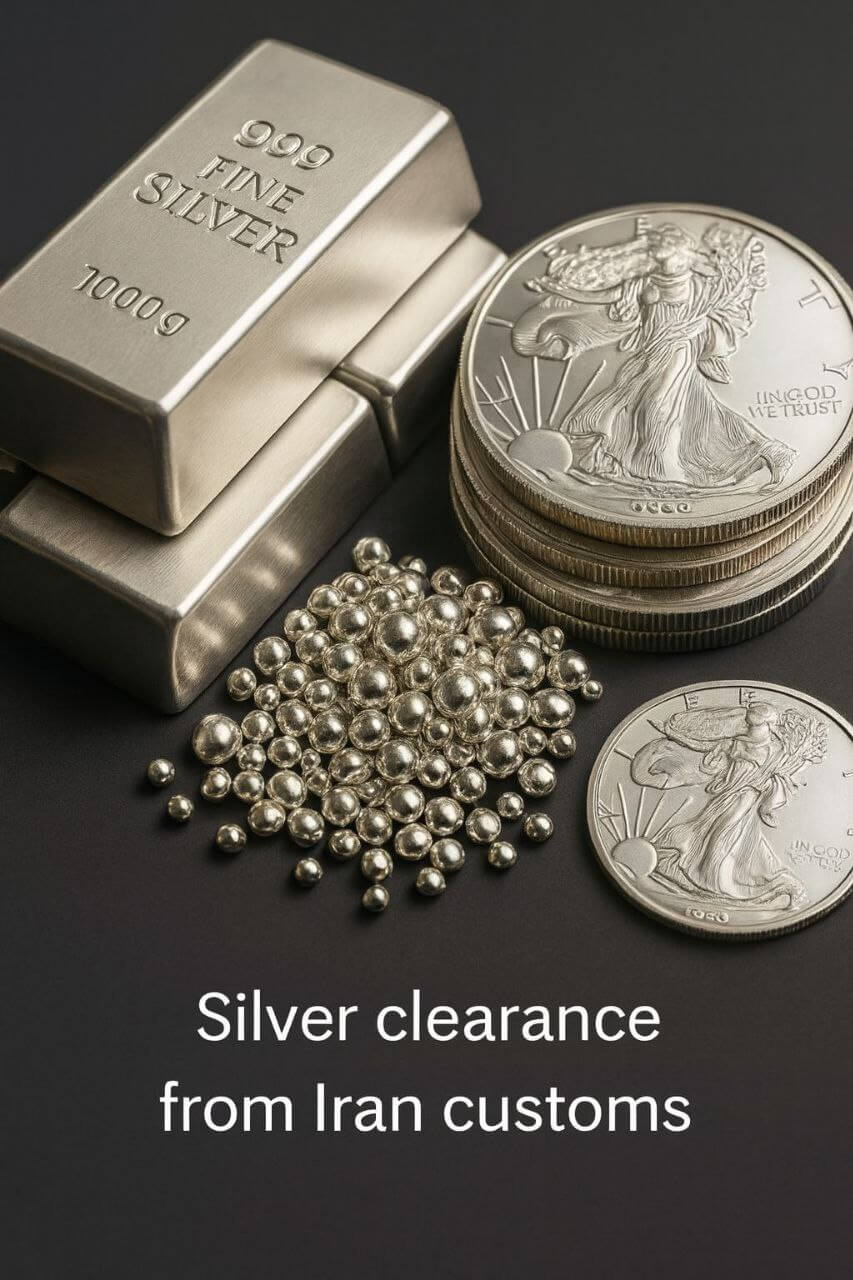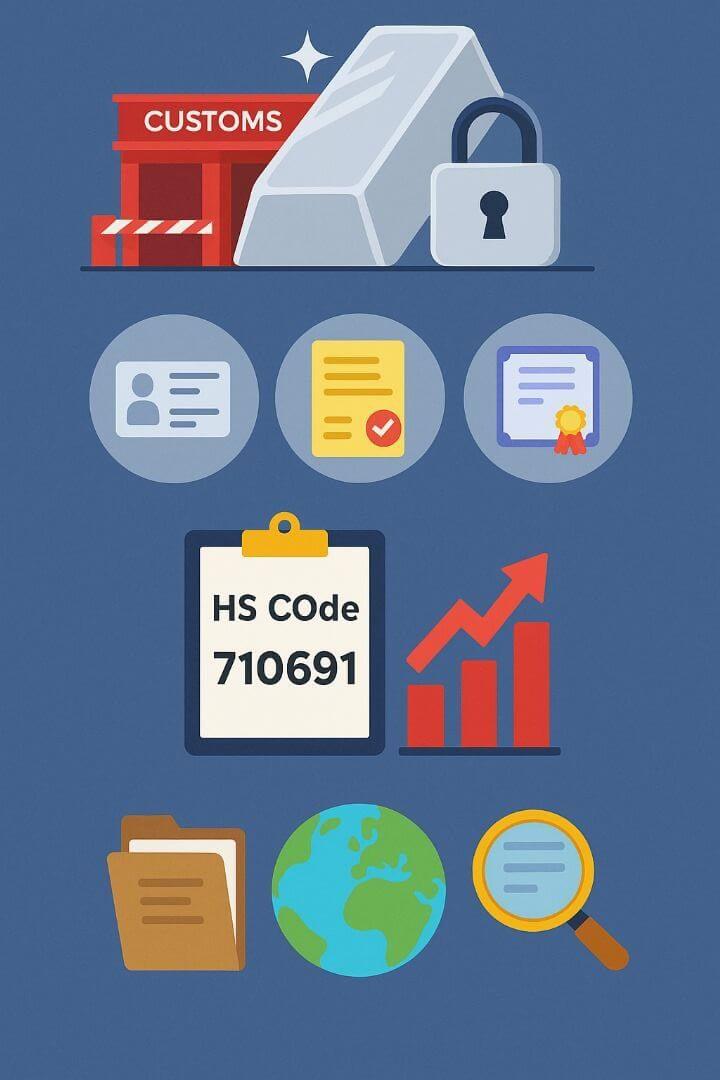Silver Customs Clearance in Iran | HS Code, Permits and Required Documents

For consultation and cost estimation of silver customs clearance, contact Saba Tarkhis experts.
Immediate and Free Consultation1) Applications of Silver in Various Industries
- Jewelry and Ornaments: The largest share of silver consumption worldwide is in jewelry manufacturing.
- Electronics: Silver is the best conductor of electricity and heat, used in printed circuit boards, wires, and sensitive components.
- Medicine and Dentistry: Its antibacterial properties make it useful in medical tools and disinfectant dressings.
- Chemical Industries: Silver is used as a catalyst in processes such as ethylene oxide production.
2) Silver Tariff and HS Code
| Item | Description | HS Code |
|---|---|---|
| Raw and Pure Silver | Without alloy; used in jewelry and industrial sectors | 7106.91 |
| Semi-finished and Processed Silver | For electronics and medical industries | 7106.92 |
3) Special Conditions for Silver Import and Export
Obtaining banking and economic permits: Because of silver’s high value, importing it usually requires permits from the Central Bank and other economic authorities. These authorizations are issued to control foreign currency flows and to provide funding for imports.
International standards and product quality: Imported silver must comply with international purity and quality standards. In many cases, imported goods must be tested and verified for purity and quality in customs laboratories.
Accurate valuation by customs experts: Due to fluctuations in global silver prices, the value of imported or exported silver may require reassessment by customs experts. This valuation determines precise customs duties and helps prevent potential violations.
Given the high value of this metal and the economic/security sensitivities involved, silver imports and exports are conducted under special conditions. Observing these rules facilitates clearance and prevents issues. These conditions include a set of permits and assessments issued by relevant authorities. This section explains these conditions and details relevant to importing and exporting silver.
1. Required permits
Because of its high value, silver requires specific government permits. The Central Bank of the Islamic Republic of Iran strictly supervises silver imports. These permits are issued to control currency flows and maintain balance in the precious metals market. In addition, permits from the National Standards Organization and the Ministry of Industry, Mine and Trade (IMT) may be required to confirm quality, check purity, and regulate imports.
2. Quality standards
Imported silver must comply with national and international standards. In Iran, silver must meet standards such as the Iranian National Standards (INSO) and international standards like ISO 9202. In many cases, imported silver samples are sent to accredited laboratories to accurately determine purity percentage. Purity is crucial, as low-purity silver may be unsuitable for sensitive industries such as electronics or medical applications.
3. Valuation
One of the most important stages in importing silver is determining its exact value. Because silver prices fluctuate in global markets, reassessment at the time of import is necessary. Customs experts determine the final value based on global prices as well as the type and purity. This valuation is essential for calculating customs duties and import taxes. Importers should note that global price changes can directly affect final import costs.
Need guidance for Central Bank permits and required standards to import silver? Saba Tarkhis manages all stages.
Submit Proforma Request4) Silver Exporting and Importing Countries
The global silver market is highly influenced by supply and demand. Below are the key exporting and importing countries:
- 1. Major silver exporters worldwide
Several countries are recognized as the largest global producers and exporters of silver. Owing to large silver mines, they hold a significant share in supplying global markets. The most important are:
Mexico: The world’s largest silver producer and exporter, shipping massive volumes annually.
Peru: The second-largest producer, and due to rich resources, a primary supplier to global markets.
China: In addition to being a major producer, it exports part of its output due to vast industrial demand.
Russia and Australia are also among key exporters, annually supplying significant volumes to global markets.
2. Countries exporting silver to Iran
Iran mainly sources silver from the following countries:
United Arab Emirates: One of the main exporters to Iran; due to close trade ties, silver is imported raw or semi-finished.
Turkey: Another major supplier; silver is typically imported as semi-finished jewelry or raw material for jewelry manufacturing.
India: A hub for silver and silver jewelry, exporting semi-finished and raw silver to Iran.
European countries are also known suppliers of pure and processed silver to Iran.
Volume of silver imports and exports in Iran
Due to extensive use in jewelry, electronics, and medical sectors, Iran’s silver imports have grown significantly in recent years. Currently, Iran imports tens of tons of silver annually. The volume varies with domestic demand and global price fluctuations.
Regarding silver exports, Iran mainly exports semi-finished silver and silver jewelry to neighboring countries. Key destinations include Iraq, Turkey, and Persian Gulf states.
Global silver circulation
The global silver market has massive annual turnover. International reports indicate that, due to widespread industrial use, global silver circulation reaches billions of dollars each year. The largest consumers are electronics and jewelry industries, which use a substantial share of total production.
5) Documents Required for Clearing Silver from Customs
1. Bill of Lading
A primary transport document containing full shipment details: consignor, consignee, commodity type, weight, and package count. It confirms carriage from origin to destination and is one of the key documents submitted to customs.
2. Commercial Invoice
Specifies commercial particulars such as price, quantity, and detailed description. Issued by the seller and submitted alongside the bill of lading. All invoice data must match other documents.
3. Certificate of Origin
Confirms the exporting country. Typically issued by the exporter’s chamber of commerce. Origin can affect tariffs, as some trade agreements reduce duties based on origin.
4. Packing List
Details packaging and package counts. Usually includes each package’s net and gross weight. It is key for customs checks and helps reconcile data with the B/L and invoice.
5. Central Bank permits
Required for importing silver into Iran. They ensure proper currency control and verification of the importer’s foreign payments. Without these permits, clearance is not possible.
6. Standard (Conformity) Certificate
Imported silver must comply with national/international standards. It may need to be tested in approved labs to verify quality and purity, evidencing compliance.
7. Customs Declaration
Submitted by the importer, detailing type and value of silver, weight, tariff code, and other specifications. Accurate information is critical.
8. Cargo Insurance Policy
Covers potential damage during transit. Submitted with other documents so the importer can claim if an incident occurs. Comprehensive coverage for silver is highly important.
9. Health Certificate
When silver is imported for medical or pharmaceutical uses, a health certificate may be required, proving safety and compliance for such applications.
10. Import License from the Ministry of Industry, Mine and Trade
For silver used in specific industries, the importer may need an IMT import license confirming legal authorization to import for that particular use.

Frequently Asked Questions
What is the HS Code for silver?
Raw silver is classified under 7106.91 and semi-finished silver under 7106.92.
Which permits are needed to import silver?
Central Bank permit, Standards Organization approval, IMT permit, and in specific cases a health certificate.
Which countries are the largest silver exporters?
Mexico, Peru, China, Russia, and Australia.
-
Special Customs Clearance Services by Saba Brokerage
For clearing silver and precious metals in Iran, choosing the right brokerage can greatly simplify and speed up the process. One of the leading teams in this field consists of experienced specialists who handle all stages of silver clearance from start to finish with precision and efficiency.
Services include:
Obtaining essential permits: The team promptly and accurately secures necessary permits, including Central Bank and Standards Organization approvals.
Specialized consulting: With technical and specialized advice, the clearance process becomes smoother and trouble-free for importers.
Meticulous follow-up: All customs stages from cargo arrival to final release are tracked carefully. Using modern methods significantly accelerates clearance.
Cost reduction: Leveraging experience and expertise, the team helps reduce customs costs and ensures silver is cleared swiftly and optimally.
By using these services, you can be confident of fast, timely clearance with minimal extra costs.
.png)
